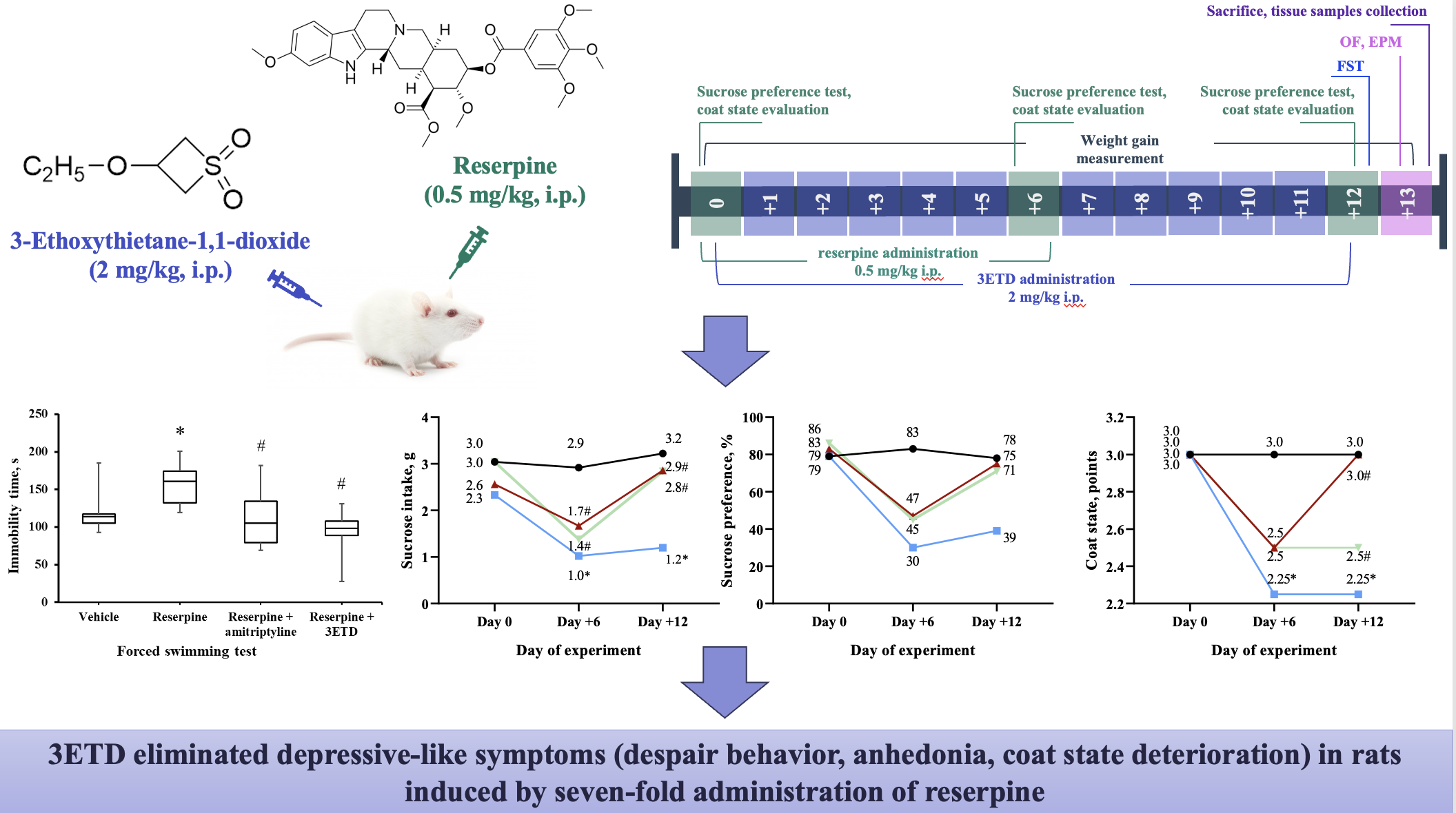Оценка антидепрессивного эффекта производного 3-замещенного тиетан-1,1-диоксида на крысиной модели депрессии, вызванной резерпином
DOI:
https://doi.org/10.18413/rrpharmacology.11.542Аннотация
Цель: охарактеризовать антидепрессивный эффект 3-этокситиетан-1,1-диоксида (3ЭТД) на модели депрессивно-подобного состояния у крыс, вызванного семикратным введением резерпина.
Материалы и методы: было проведено 2 эксперимента на белых неинбредных крысах-самцах. В Эксперименте 1 резерпин (0,5 мг/кг) вводили с 0 по +6 сутки ежедневно внутрибрюшинно (в/б), 3ЭТД (2 мг/кг) и референтный препарат амитриптилин (10 мг/кг) – с 0 по +11 сутки ежедневно в/б. Оценивали потребление и предпочтение сахарозы (0, +6, +12 сутки), внешний вид крыс (0, +6, +12 сутки), поведение животных в тестах «принудительное плавание» (ТПП, +12 сутки), «открытое поле» (ОП, +13 сутки) и «приподнятый крестообразный лабиринт» (ПКЛ, +13 сутки), массу тела (ежедневно). На + 13 сутки животных выводили из эксперимента и измеряли весовые коэффициенты их внутренних органов (печени, селезенки, тимуса, надпочечников), содержание мозгового нейротрофического фактора (BDNF) в гиппокампе крыс методом иммуноферментного анализа (ИФА), а также проводили биохимический анализ крови крыс. В Эксперименте 2 резерпин, амитриптилин и 3 ЭТД вводили по схеме Эксперимента 1, на +13 сутки крыс подвергали эвтаназии и извлекали головной мозг для последующего иммуногистохимического определения глиального фибриллярного кислого белка (GFAP) и антиапоптотического белка семейства B-клеточной лимфомы 2 (Bcl-2) в гиппокампе.
Результаты и обсуждение: семикратное введение резерпина приводило к значительному увеличению длительности иммобилизации (ДИМ) в ТПП, ангедонии, дефициту самоухода, снижению двигательной активности в ОП и ПКЛ, снижению массы тела, увеличению весовых коэффициентов надпочечников и селезенки (Эксперимент 1), повышению уровня GFAP и снижению уровня Bcl-2 в гиппокампе (Эксперимент 2). 3ЭТД (2 мг/кг) сравнимо с амитриптилином (10 мг/кг) значимо снижал ДИМ ТПП на 39%, повышал потребление сахарозы на 36-137%, устранял ангедонию и дефицит самоухода по сравнению с группой резерпина, а также препятствовал снижению массы тела крыс в динамике (Эксперимент 1); значимо снижал уровень GFAP в гиппокампе (в зонах СА1-СА4 и зубчатой извилине) и повышал уровень Bcl-2 (в СА1 и зубчатой извилине) по сравнению с резерпином (Эксперимент 2).
Выводы: 3ЭТД эффективно корригировал депрессивно-подобные проявления у крыс, вызванные семикратным введением резерпина.
Графическая аннотация

Ключевые слова:
тиетаны, антидепрессивная активность, неинбредные крысы, резерпин, депрессияБиблиографические ссылки
Akhapkin RV, Bukreeva ND, Vazagaeva TI, Kostyukova EG, Mazo GE, Mosolov SN (2021) Depressive Episode, Recurrent Depressive Disorder. Clinical recommendations. Ministry of Health of the Russian Federation, Moscow, 89 pp.
Antkiewicz-Michaluk L, Wąsik A, Możdżeń E, Romańska I, Michaluk J (2015) Withdrawal from repeated administration of a low dose of reserpine induced opposing adaptive changes in the noradrenaline and serotonin system function: a behavioral and neurochemical ex vivo and in vivo studies in the rat. Progress in Neuro-Psychopharmacology & Biological Psychiatry 57: 146–154. https://doi.org/10.1016/j.pnpbp.2014.10.009 [PubMed]
Costa-Ferreira W, Morais-Silva G, Gomes-de-Souza L, Marin MT, Crestani CC (2019) The AT1 receptor antagonist losartan does not affect depressive-like state and memory impairment evoked by chronic stressors in rats. Frontiers in Pharmacology 10: 705. https://doi.org/10.3389/fphar.2019.00705 [PubMed] [PMC]
Czéh B, Fuchs E, Wiborg O, Simon M (2016) Animal models of major depression and their clinical implications. Progress in Neuro-Psychopharmacology & Biological Psychiatry 64: 293–310. https://doi.org/10.1016/j.pnpbp.2015.04.004 [PubMed]
Dean J, Keshavan M (2017) The neurobiology of depression: An integrated view. Asian Journal of Psychiatry 27: 101–111. https://doi.org/10.1016/j.ajp.2017.01.025 [PubMed]
Duclot F, Kabbaj M (2015) Epigenetic mechanisms underlying the role of brain-derived neurotrophic factor in depression and response to antidepressants. Journal of Experimental Biology 218(Pt 1): 21–31. https://doi.org/10.1242/jeb.107086[PubMed] [PMC]
El-Marasy SA, El Awdan SA, Hassan A, Ahmed-Farid OA, Ogaly HA (2021) Anti-depressant effect of cerebrolysin in reserpine-induced depression in rats: Behavioral, biochemical, molecular and immunohistochemical evidence. Chemico-Biological Interactions 334: 109329. https://doi.org/10.1016/j.cbi.2020.109329 [PubMed]
Gaisina GG, Nikitina IL (2020) Study of the range of effective doses of a new 3-substituted thietane-1,1-dioxide derivative. Bashkortostan Medical Journal [Meditsinskii Vestnik Bashkortostana] 15: 48–50. [in Russian]
Habriev RU (2005) Guidelines for the Experimental (Preclinical) Trial of New Pharmacological Substances. Medicine Publishing House JSC, Moscow, 832 pp. [in Russian]
Herrman H, Patel V, Kieling C, Berk M, Buchweitz C, Cuijpers P, Furukawa TA, Kessler RC, Kohrt BA, Maj M, McGorry P, Reynolds CF, Weissman MM, Chibanda D, Dowrick C, Howard LM, Hoven CW, Knapp M, Mayberg HS, Penninx BWJH, Xiao S, Trivedi M, Uher R, Vijayakumar L, Wolpert M (2022) Time for united action on depression: a Lancet-World Psychiatric Association Commission. Lancet (London, England) 399(10328): 957–1022. https://doi.org/10.1016/S0140-6736(21)02141-3 [PubMed]
Khaliullin FA, Nikitina IL, Klen EÉ, Gaisina GG, Makarova NN (2020) Synthesis, antidepressant activity, and prediction of toxic risks of 3-alkoxy(sulfanyl)thietane-1,1-dioxides. Pharmaceutical Chemistry Journal 53: 1106–1112. https://doi.org/10.1007/s11094-020-02131-z
Klen EE, Nikitina IL, Makarova NN, Miftakhova AF, Ivanova OA, Khaliullin FA, Alekhin EK (2017) 3-substituted thietane-1,1-dioxides: synthesis, antidepressant activity, and in silico prediction of their pharmacokinetic and toxicological properties. Pharmaceutical Chemistry Journal 50: 642–648. https://doi.org/10.1007/s11094-017-1506-6
Ménard C, Hodes GE, Russo SJ (2016) Pathogenesis of depression: insights from human and rodent studies. Neuroscience 321: 138–162. https://doi.org/10.1016/j.neuroscience.2015.05.053 [PubMed] [PMC]
Nikitina IL, Gaisina GG (2022) Involvement of monoaminergic system in the antidepressant effect of 3-substituted thietane-1,1-dioxide derivative. Research Results in Pharmacology 8: 87–94. https://doi.org/10.3897/rrpharmacology.8.81007
Nikitina IL, Gaisina GG, Samorodov AV (2022) The mechanism of antidepressant action of a new 3-substituted thiethane-1,1-dioxide derivative in tests of neuropharmacological interaction. Research Results in Pharmacology 8(2): 175–183. https://doi.org/10.3897/rrpharmacology.8.86560 [PubMed] [PMC]
Packard AEB, Egan AE, Ulrich-Lai YM (2016) HPA axis-interaction with behavioral systems. Comprehensive Physiology 6(4): 1897–1934. https://doi.org/10.1002/cphy.c150042 [PubMed] [PMC]
Park B-K, Kim YR, Kim YH, Yang C, Seo C-S, Jung IC, Jang I-S, Kim S-H, Lee MY (2018) Antidepressant-like effects of gyejibokryeong-hwan in a mouse model of reserpine-induced depression. Biomed Research International 2018: 5845491. https://doi.org/10.1155/2018/5845491 [PubMed] [PMC]
Paxinos G, Watson C (2006) The Rat Brain in Stereotaxic Coordinates: Hard Cover Edition. Elsevier, London, 451 pp.
Petković A, Chaudhury D (2022) Encore: Behavioural animal models of stress, depression and mood disorders. Frontiers in Behavioral Neuroscience 16. https://doi.org/10.3389/fnbeh.2022.931964 [PubMed] [PMC]
Porsolt RD (1979) Animal model of depression. Biomedicine 30(3): 139–140. [PubMed]
Santomauro DF, Herrera AMM, Shadid J, Zheng P, Ashbaugh C, Pigott DM, Abbafati C, Adolph C, Amlag JO, Aravkin AY, Bang-Jensen BL, Bertolacci GJ, Bloom SS, Castellano R, Castro E, Chakrabarti S, Chattopadhyay J, Cogen RM, Collins JK, Dai X, Dangel WJ, Dapper C, Deen A, Erickson M, Ewald SB, Flaxman AD, Frostad JJ, Fullman N, Giles JR, Giref AZ, Guo G, He J, Helak M, Hulland EN, Idrisov B, Lindstrom A, Linebarger E, Lotufo PA, Lozano R, Magistro B, Malta DC, Månsson JC, Marinho F, Mokdad AH, Monasta L, Naik P, Nomura S, O’Halloran JK, Ostroff SM, Pasovic M, Penberthy L, Jr RCR, Reinke G, Ribeiro ALP, Sholokhov A, Sorensen RJD, Varavikova E, Vo AT, Walcott R, Watson S, Wiysonge CS, Zigler B, Hay SI, Vos T, Murray CJL, Whiteford HA, Ferrari AJ (2021) Global prevalence and burden of depressive and anxiety disorders in 204 countries and territories in 2020 due to the COVID-19 pandemic. The Lancet 398(10312): 1700–1712. https://doi.org/10.1016/S0140-6736(21)02143-7 [PubMed] [PMC]
Sestakova N, Puzserova A, Kluknavsky M, Bernatova I (2014) Determination of motor activity and anxiety-related behaviour in rodents: methodological aspects and role of nitric oxide. Interdisciplinary Toxicology 6(3): 126–135. https://doi.org/10.2478/intox-2013-0020 [PubMed] [PMC]
Strekalova T, Couch Y, Kholod N, Boyks M, Malin D, Leprince P, Steinbusch HM (2011) Update in the methodology of the chronic stress paradigm: internal control matters. Behavioral and Brain Functions 7: 9. https://doi.org/10.1186/1744-9081-7-9 [PubMed] [PMC]
White S (2019) Basic & Clinical Biostatistics: Fifth Edition. McGraw-Hill Education, New York, 368 pp.
Zaazaa AM, Daoud NN, El-Gendy OA, Al-Shafei AI (2022) Neuroprotective role of Bacopa monnieri extract in modulating depression in an experimental rat model. Journal of Affective Disorders 308: 229–235. https://doi.org/10.1016/j.jad.2022.04.021 [PubMed]
Zamudio S, Fregoso T, Miranda A, De La Cruz F, Flores G (2005) Strain differences of dopamine receptor levels and dopamine related behaviors in rats. Brain Research Bulletin 65(4): 339–347.https://doi.org/10.1016/j.brainresbull.2005.01.009 [PubMed]
Загрузки
Опубликован
Как цитировать
Выпуск
Раздел
Лицензия
Copyright (c) 2025 Irina L. Nikitina, Gulnara G. Gaisina, Elena E. Klen, Lyubov A. Tkachenko

Это произведение доступно по лицензии Creative Commons «Attribution» («Атрибуция») 4.0 Всемирная.
 Русский
Русский
 English
English

